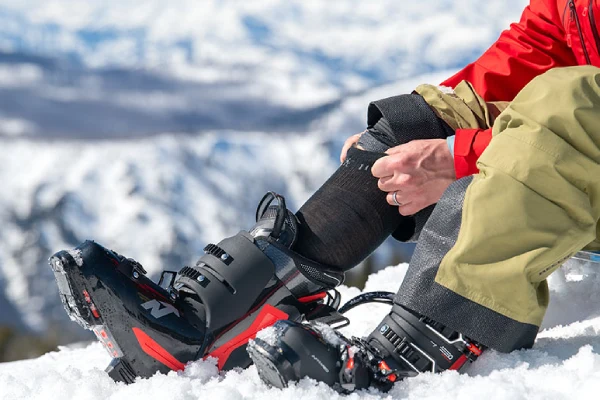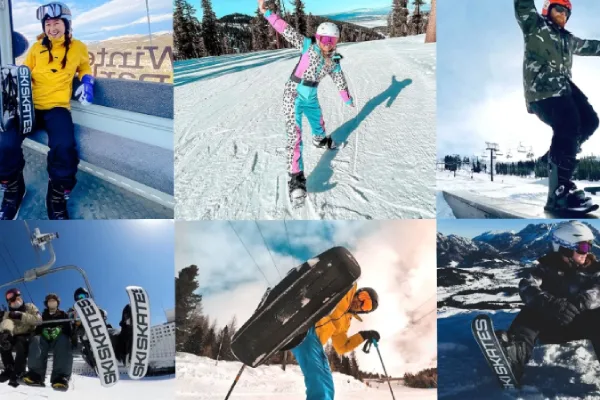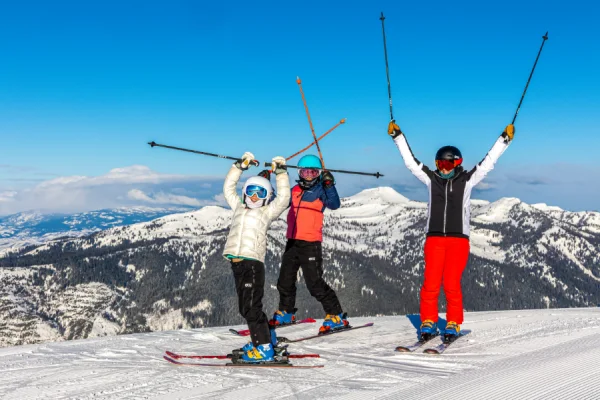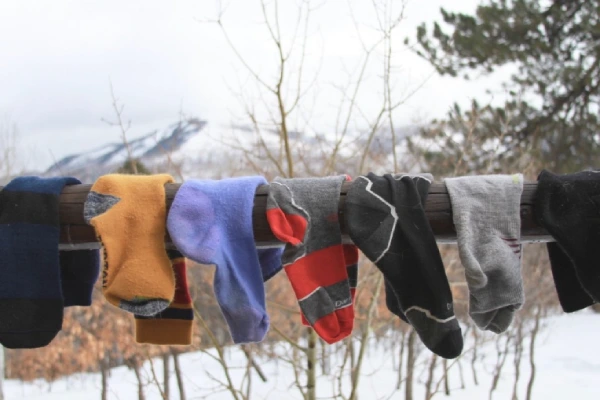Whether you ski gates, lap the park, crush long Nordic sessions, or guide guests all day, your discipline and effort level dictate what you need from your socks. This page is a decision hub: scan the overview, pick your skiing style, and jump to the focused guide that matches your movement pattern, boot type, and time on snow.
New to ski socks? For beginner-friendly “what to wear” basics, see What Socks to Wear When Skiing and Snowboarding.
Want the science behind fiber choices and fit? Visit Materials Science and Cushioning & Boot Fit Whitepaper.
Curious about compression? Read Understanding Ski Socks vs Compression Socks (we use “support zones,” not medical-grade compression).
Decision Snapshot (Quick Comparison)
| Discipline | Typical Intensity | Fit / Cushion Focus | Breathability / Odor Focus |
|---|---|---|---|
| ⛷️ Alpine / Downhill | Medium, intermittent (lift rides + runs) | Precise boot fit; targeted shin & toe padding | Moderate breathability for chairlift chill |
| 🏃♂️ Cross-Country (XC) | High, continuous | Light, close fit; arch & ankle support zones | High breathability & fast dry for sweat management |
| 🏔️ Backcountry / Touring | Medium–High, extended duration | Light, secure fit for long climbs | Odor resistance for multi-day use; efficient moisture transport |
| 🛹 Freestyle / Park | Bursty, high-impact | Heel & shin impact padding; anti-slip fit | Balanced breathability for hike-to features |
| 🚑 Ski Patrol & Instructors | Long hours, variable | Comfort-first fit; durability; rotation-friendly | Odor control & easy care |
| 👧 Women & Kids | Varies by size/skill | Anatomical sizing; soft handfeel | Skin-friendly, low-irritation interiors |
How Style Changes What You Need from a Sock

Skip the theory—use these on-snow signals to tune features by discipline and effort. Each fix points you to a deeper guide.
- Movement Intensity → Sweat Rate
Signals: damp instep after a couple of runs; “pruny” toes; sock feels heavy; hot spots on the arch.
Fix: prioritize ventilation zones over the instep/ankle, lighter gauge knits, and quicker-dry blends; rotate pairs at lunch. - Boot Interface → Stiffness & Cuff Height
Signals: shin tenderness after 3–5 laps; toe numbness mid-run; seams felt at the toe box.
Fix: choose targeted shin padding, seamless toe, and a Y-heel for lock-in; keep total sock volume in check (padding should be targeted, not full-thick). If numbness appears, reduce the cushion or adjust the buckle tension/liner per fit best practices. - Exposure Profile → Lifts vs Constant Motion
Signals: cold on lifts, sweaty on runs; feet swing between chilled and clammy.
Fix: pick a mid-thickness with focused padding plus strong moisture transport; avoid double-socking (adds wrinkles and pressure). For truly cold lift days, pair socks with heated insoles or toe warmers, not thicker, bulkier socks. - Session Length & Day Count
Signals: odor after day one; skin irritation by day two; slow overnight drying.
Fix: favor odor-resistant blends for multi-day trips, quick-dry mesh zones, and a 2–3 pair rotation. Swap a fresh pair mid-day on hut trips.
Choose by Discipline (Jump-Off Cards)

Alpine / Downhill — Precision Under Load, Warmth on Lifts
Best for: resort laps, carving days, race-training warmups
Workload profile: intermittent; lift exposure often 30–50% of time; cuff stiffness high; repeated tongue pressure.
Sock spec cues: over-the-calf height; targeted shin pad (~1–2 mm terry); seamless toe; secure heel cup/Y-heel; overall volume controlled for feel.
On-snow checks (5–10 min): after 3 laps, press along shin—tenderness = pad needed or buckle tension review; if toe tingle <10 min into a run, reduce cushion or loosen forefoot buckle one click.
Failure modes → fixes:
- Cold on lifts / hot on runs → keep targeted (not full-thick) padding; pair with heated insoles instead of thicker socks.
- Shin bang after 5+ laps → upgrade to denser shin zone; confirm tongue alignment; see boot-fit whitepaper.
Cross-Country (XC) — High Output, Zero Drag
Best for: classic, skate, biathlon, cardio blocks
Workload profile: continuous; HR high; sweat rate high; low cuff, high ankle ROM.
Sock spec cues: ultra-light gauge, close wrap; instep/ankle mesh; arch/ankle support zones (non-medical); toe seam truly flat.
On-snow checks (tempo 20–30 min): remove boot—if sock mass feels heavier or instep is pruny, you need more mesh / faster-dry synthetics or mid-day rotation.
Failure modes → fixes:
- Sloshy dampness → step down knit density; add polypropylene/nylon dominant blend.
- Arch hot spots → verify toe seam flatness + arch band not biting; micro-adjust lacing if applicable.
Backcountry / Touring — Lightweight, Odor-Resistant, All-Day Comfort
Best for: skin tracks, hut trips, mixed-temp objectives
Workload profile: long climbs, transitions, variable temps; limited washing; blister risk on heel/forefoot.
Sock spec cues: low mass with odor-resistant blend; smooth interior; minimal toe bulk; heel lock stable for kick turns.
On-snow checks (first climb 45–60 min): after transition, inspect heel/first MTP—any hot spot = reduce sock bulk or adjust walk-mode cuff; tape early, not late.
Failure modes → fixes:
- Day two odor/irritation → move to higher-merino blend with mapped mesh; practice 2–3 pair rotation.
- Heel rub on steeps → confirm Y-heel fit; re-seat liner; consider thinner, denser knit for less migration.
Freestyle / Park — Cushion for Impact, Lock-In for Tricks
Best for: jumps, rails, pipe, hike-to features
Workload profile: bursty impacts; frequent boot flex extremes; occasional hiking in boots.
Sock spec cues: heel & shin impact zones (dense, not spongy); grippy heel fit; seamless toe; overall mid-thin body to keep board feel.
On-snow checks (hike line 15–20 min): if sock creeps down or twists after a set, escalate to firmer heel cup / tighter ankle band; if landings sting the heel, choose denser heel pad (not thicker everywhere).
Failure modes → fixes:
- Shin bite on tall lips → taller OTC and beefier shin zone; tune boot tongue.
- Swampy feet on repeats → add dorsal mesh; swap at lunch.
Ski Patrol & Instructors — Comfort that Survives the Shift

Best for: all-day pros, mixed weather, assisting/standing
Workload profile: long static periods + bursts; frequent don/doff; frequent washes.
Sock spec cues: durable nylon reinforcements at heel/toe; odor tech; gentle support zones to reduce fatigue; easy-care knit that dries overnight.
On-snow checks (mid-shift): if feet feel “boxed” or numb after standing, reduce cushion a step or adjust buckle tension; maintain daily rotation.
Failure modes → fixes:
- Odor by day three → alternate blends; wash/air with warm airflow; consider silver-treated pair for peak days.
- Early pilling/heel wear → move to higher-denier nylon reinforcement.
Women & Kids — Fit, Comfort, and Skin Friendliness
Best for: smaller sizes, developing skills, sensitive skin
Workload profile: variable intensity; higher chill sensitivity; rapid comfort drop if seams irritate.
Sock spec cues: true anatomical sizing, soft handfeel interiors, low-profile toe seam, gentle calf grip for smaller circumferences.
On-snow checks (first hour): look for toe wiggle without seam awareness; if kids tug at cuffs or say “scratchy,” switch to finer-gauge interior and re-fit calf grip.
Failure modes → fixes:
- Cold complaints despite thicker socks → step down bulk and improve boot fit & circulation (see whitepaper).
- Red marks at seam lines → insist on seamless toe + smoother interior yarns.

Build Your Rotation (Without Repeating the Basics)
Think in roles, not duplicates. Keep 2–3 core pairs: an impact pair for park, a precision pair for carving, and an endurance pair for long days. Add one range-extender for cold snaps or plan changes. For a weekend, pack precision + range-extender; for a five-day mixed week, rotate impact + precision + range-extender; for touring or hut trips, alternate two touring-ready pairs so one can air out. Keep a simple care rhythm: rotate 24 h, air-dry inside-out, wash every 1–3 uses. Retire socks when support slackens or padding thins.
FAQs
What ski socks are best for park impacts and shin bang?
Midweight ski socks with targeted shin and heel cushioning, a locked-in fit (arch band, Y-heel), and a seamless toe. They buffer tongue pressure and absorb landings without overfilling the boot. Avoid overly thick, spongy socks that reduce edge feel.
Are thin socks better for cross-country skiing?
Yes, for most XC. Choose lightweight, close-fitting socks in breathable, fast-drying synthetics or light merino blends, with minimal cushioning and ventilation over the instep. This preserves stride efficiency, limits overheating, and reduces moisture buildup.
How should ski patrol and instructors rotate socks?
Keep 2–3 pairs in rotation. Prioritize comfort, durability, and odor control (merino-rich blends), and alternate daily so fibers dry fully. Replace socks when cushioning packs out or the cuff loses recovery to maintain foot health on long shifts.
Do touring socks need to be warm or just light?
Both. Pick low-bulk, thermally efficient blends (e.g., merino + nylon) that manage sweat on climbs and retain heat during transitions, with anti-odor properties for multi-day trips. Avoid double-socking; rely on targeted cushioning and proper boot fit.
Do ski socks provide compression?
Most provide light support zones, not medical-grade compression. For circulation or recovery, choose graduated compression with a stated mmHg rating, and avoid stacking under overly tight boots. For everyday skiing, supportive ski socks are usually sufficient.
Conclusion
Choosing socks by discipline and intensity helps you align padding, fit, and breathability with how you actually ski—then fine-tune with the dedicated sub-guides above.
For B2B custom projects or bulk orders, visit our website to start your request and connect with our team for advanced ski socks specs, sampling, and lead times: www.icompressionsocks.com.
